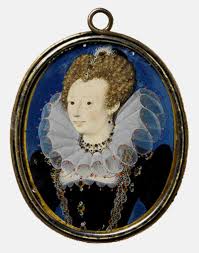Essex Rebellion
Chapter 5 : Rebellion
Essex arrived at Nonsuch, where the Queen was staying, at 10 o’clock on the morning of 28th September. Covered in mud, he brooked no delay but burst into the Queen’s own bedroom, to find her still in her night-clothes (Elizabeth was not an early riser). She asked him to come back an hour later, when she listened to his recital of events calmly. Shortly after, she changed her stance and requested the Privy Council to interrogate him on charges of gross disobedience.
He was put under house arrest whilst the matter was investigated. Essex’ family, including his sister, Penelope, Lady Rich, tried to intercede for him, but to no avail. Found guilty of the charges, he was suspended from public office and his liberty was restricted until August of 1600. Although he was then free to come and go, he was not restored to the Queen’s favour. She refused to continue the grant of the monopoly on the import of sweet wines which was his principle source of income. Essex had been extravagant since his boyhood and this loss meant financial ruin.

In the meantime, the Queen and Cecil had been advancing towards peace in the Netherlands with the new Governors, the Archduke Albert and his wife, the Infanta Isabella Clara Eugenia (who was a possible successor to Elizabeth via her descent from John of Gaunt.)
Essex saw this as a betrayal of him, and his supporters (and perhaps the Earl himself) stepped up a libel campaign that lampooned Cecil as a ‘camel’ (in reference to his scoliosis) and accused him of being an evil influence on the Queen, and thirsting to destroy Essex. The slanders were extended to others of the Queen’s Council, who were seen as enemies – the Earl of Nottingham, Sir Walter Raleigh and Lord Cobham. They were even accused of plotting on behalf of the Infanta Isabella.
Essex began to arm himself and his followers, collecting men and arms at Essex House. On 6th February 1601, his supporters paid 40s to the Lord Chamberlain’s Men to perform Shakespeare’s play, Richard II. The play was extremely controversial, as it portrayed the deposition of Richard II by Henry Bolingbroke, and when it had been performed at court, the Queen had been heard to comment
‘I am Richard II, know ye not that?’
Faced with such obvious hints of rebellion, the Privy Council decided on a pre-emptive strike. On 7 February 1601, Essex was summoned to explain his actions. Retention of liveried men beyond the number required for household servants was illegal, and potentially treasonable. The Essex men barricaded the house, and the next day, when four Privy Councillors, including the Lord Keeper, Thomas Egerton, were sent to fetch Essex, they were taken hostage.
Essex, together with Sir Christopher Blount (his step-father), the Earl of Southampton and about twenty others, set out for the City of London. (Essex House was outside its walls). They called out that they were for the Queen, and that Cecil, Sir Walter Raleigh and Lord Cobham were plotting to murder Essex and to sell the Crown to the Infanta of Spain.
They managed to gather about 300 men, but the City grandees refused support. Essex and the men retreated to Essex House, and soldiers, led by the Earl of Northampton, surrounded it, drawing up cannon. Whilst his sister, Penelope, tried to keep the soldiers at bay by attempting to negotiate terms, Essex hastily burned all of his correspondence, including his letters to James VI of Scotland.
Once all of the incriminating material was gone, he surrendered , and was dispatched, after a night at Lambeth Palace, to the Tower. Within a fortnight, he and Southampton had been tried and found guilty. The sentence was, of course, death. Essex faced his judges with dignity and resolution in the court, but the next day, he strove to exculpate himself by naming his sister, and her lover, Lord Mountjoy, saying that Penelope had ‘continually urge[d]’ him on.
But there was no reprieve, and on 25th February 1601, he was beheaded. Southampton was reprieved, but Blount and three others were also executed.
